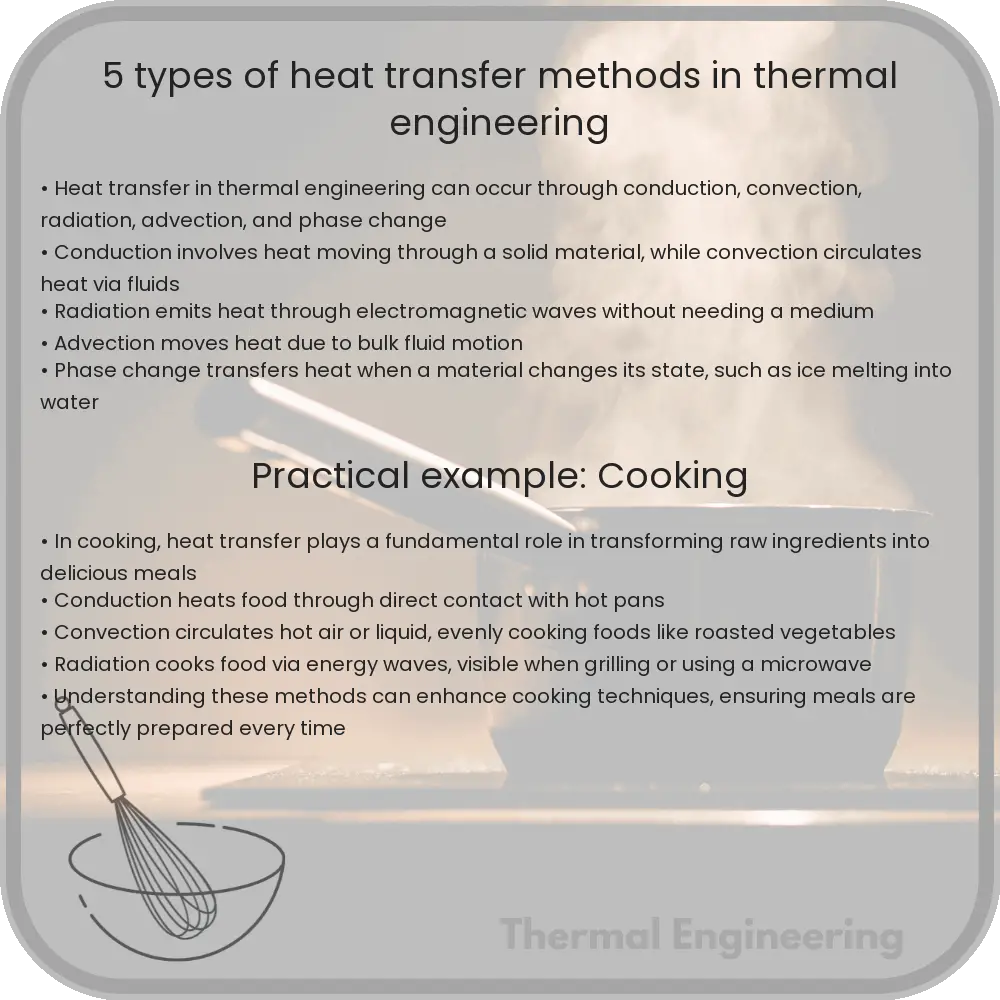Learn about the five primary methods of heat transfer in thermal engineering: conduction, convection, radiation, advection, and phase change.

Understanding Heat Transfer: 5 Methods in Thermal Engineering
Heat transfer is a fundamental aspect of thermal engineering, playing a crucial role in various applications, from industrial manufacturing to HVAC systems in buildings. Essentially, it involves the movement of heat from one place to another, which can occur in several ways. This article delves into five primary methods of heat transfer: conduction, convection, radiation, advection, and phase change.
1. Conduction
Conduction is the process of heat transfer through a solid material from one molecule to another without any movement of the material as a whole. It occurs when a temperature gradient exists within a solid, prompting heat to flow from the warmer to the cooler regions. The rate of heat transfer by conduction can be described using Fourier’s law of heat conduction:
Q = -k * A * (dT/dx)
- Q is the heat transfer rate (in watts, W)
- k is the thermal conductivity of the material (in watts per meter-Kelvin, W/m∙K)
- A is the cross-sectional area through which heat is being transferred (in square meters, m2)
- dx is the thickness of the material (in meters, m)
- dT is the temperature difference across the material (in Kelvin, K)
2. Convection
Convection is the transfer of heat within a fluid (gas or liquid) through the motion of the fluid itself. This motion arises from differences in fluid density, affected by temperature variations within the fluid. Convection can be categorized as either natural or forced. Natural convection results from buoyancy-driven flow; heated fluid expands, becomes less dense, and rises, whereas cooler fluid contracts and sinks. Forced convection, on the other hand, involves external forces such as fans or pumps to circulate the fluid. Convection can be quantitatively described by Newton’s law of cooling:
Q = h * A * (Ts – Tf)
- Q is the rate of heat transfer (in watts, W)
- h is the convective heat transfer coefficient (in watts per square meter-Kelvin, W/m2∙K)
- A is the area through which heat is being transferred (in square meters, m2)
- Ts is the surface temperature
- Tf is the fluid temperature
3. Radiation
Radiation is the process by which heat is transferred in the form of electromagnetic waves. Unlike conduction and convection, radiation does not require any medium to occur. It can occur in a vacuum, as demonstrated by solar radiation reaching Earth. The amount of radiant energy emitted by a surface is given by the Stefan-Boltzmann law:
Q = ε * σ * A * T4
- Q is the rate of heat transfer (in watts, W)
- ε is the emissivity of the surface (dimensionless)
- σ is the Stefan-Boltzmann constant (5.67 x 10-8 W/m2∙K4)
- A is the area of the surface (in square meters, m2)
- T is the absolute temperature of the surface (in Kelvin, K)
4. Advection
Advection is a type of heat transfer that often gets confused with convection. However, advection refers specifically to the transfer of heat by the large-scale movement of groups of molecules in liquids and gases. It is usually seen in meteorology, oceanography, and environmental engineering, where it plays a significant role in the distribution of heat across the earth’s surface and atmosphere.
5. Phase Change
Heat transfer during phase change is a critical aspect of thermal systems, particularly in applications involving the boiling or condensing of fluids. During a phase change, heat transfer is primarily due to the energy absorbed or released when a substance changes its state (e.g., solid to liquid, liquid to gas). This type of heat transfer is crucial in refrigeration, air conditioning systems, and boilers.
Each of these heat transfer methods has unique characteristics and is important in specific applications. Understanding how they work helps in designing efficient thermal systems for everyday applications and industrial processes.